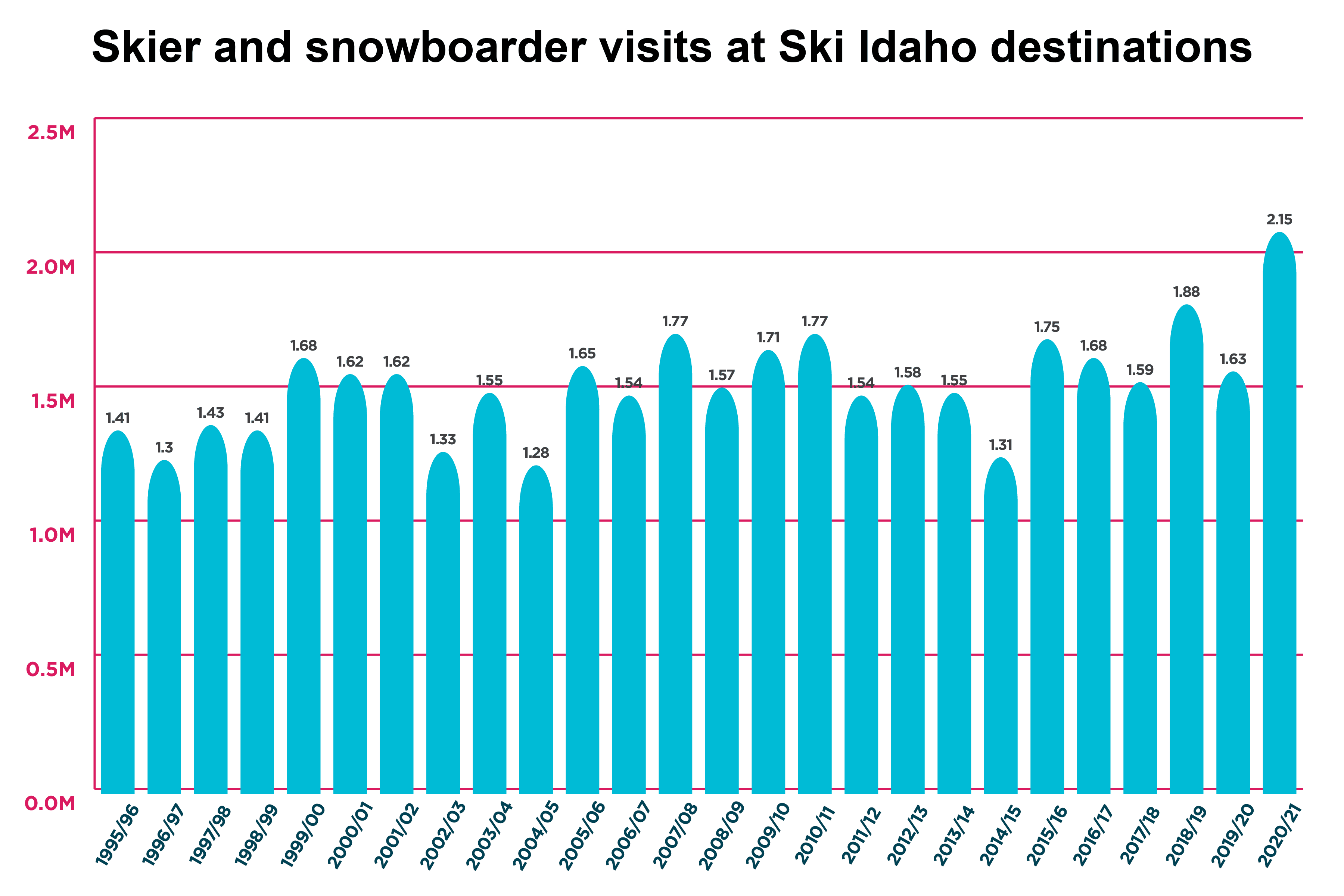
Rebounding from the COVID-19 pandemic, Idaho ski areas experienced record-breaking skier and snowboarder visits during the winter of 2020-21 according to an economic impact report Ski Idaho commissioned from Boulder, Colo.-based research firm RRC Associates.
Idaho ski areas achieved 2.15 million skier and snowboarder visits during the winter of 2020-21, exceeding its previous record of 1.88 million set during the pre-COVID winter of 2018-19 by 14.3 percent and extending what Ski Idaho president and Bogus Basin general manager Brad Wilson says is a long-term growth trend.
The COVID-19 pandemic brought the winter 2019-20 ski season to an early close and visits to Idaho ski destinations dipped to 1.63 million.
“It didn’t take long for Idaho ski areas to respond to and rebound from COVID. After social distancing for nine months, people were eager to get outside, and many of them discovered how wonderful it is to spend time skiing and snowboarding in Idaho’s outdoors.”
– Ski Idaho president and Bogus Basin general manager Brad Wilson
RRC also found that Idaho ski areas have enjoyed a slightly rising share of western U.S. skier and snowboarder visits, peaking at 6.2 percent in winter 2020-21, the most recent ski season for which data is available. The study also revealed Idaho ski areas account for a growing share of skier and snowboarder visits nationally, rising to 3.6 percent during the winter of 2020-21.
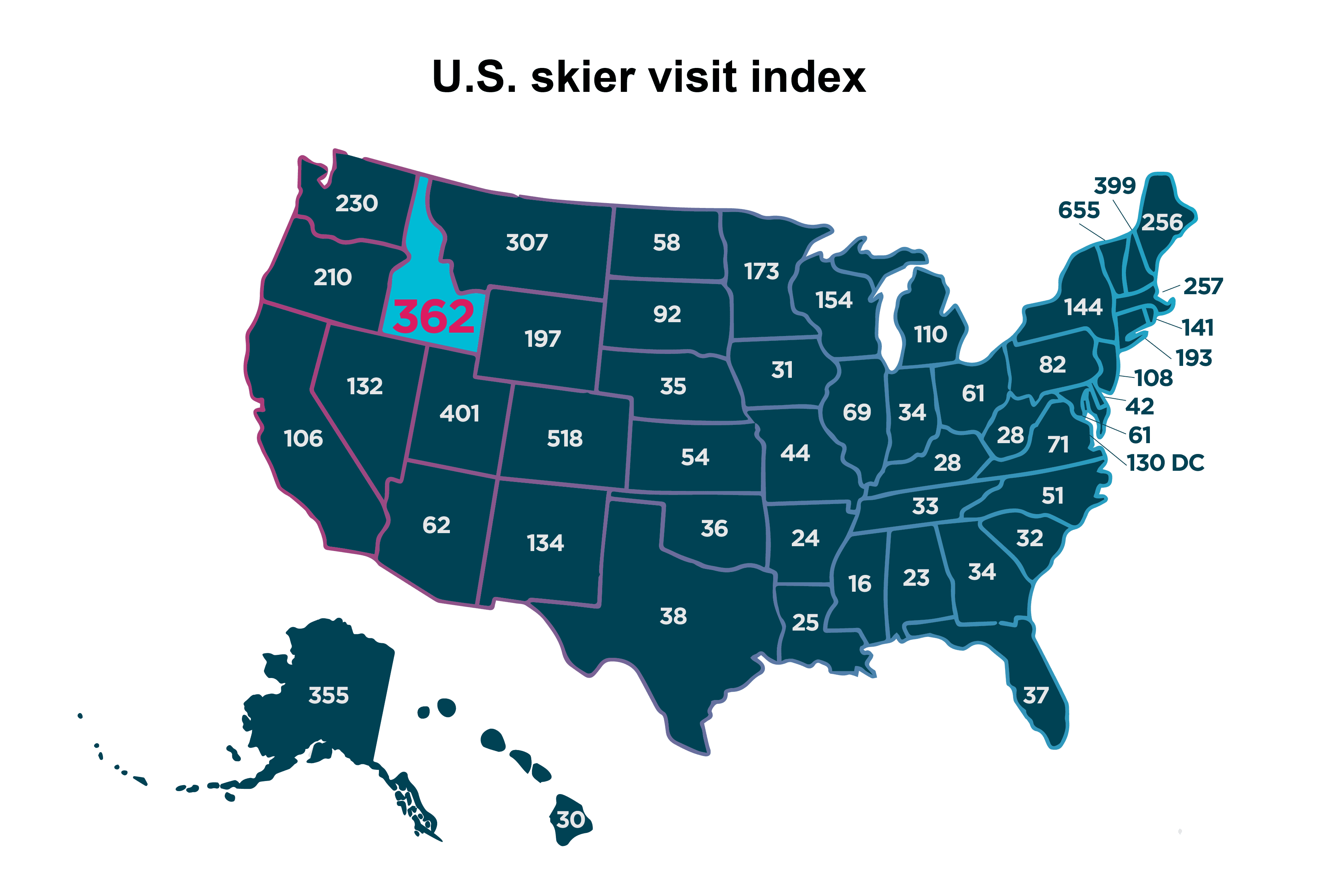
Fifth Highest in Skier Days Per Capita
Idaho is the fifth highest state in terms of skier days per capita, earning an index of 362, which means Idaho residents enjoy 3.62 times more skier days per capita than average. The only states with higher skier visit indexes are Vermont (655), Colorado (518), Utah (401), and New Hampshire (399).
Approximately 140,000-160,000 Idaho residents—7 percent to 8 percent of the state’s population—downhill ski or snowboard in a given season.
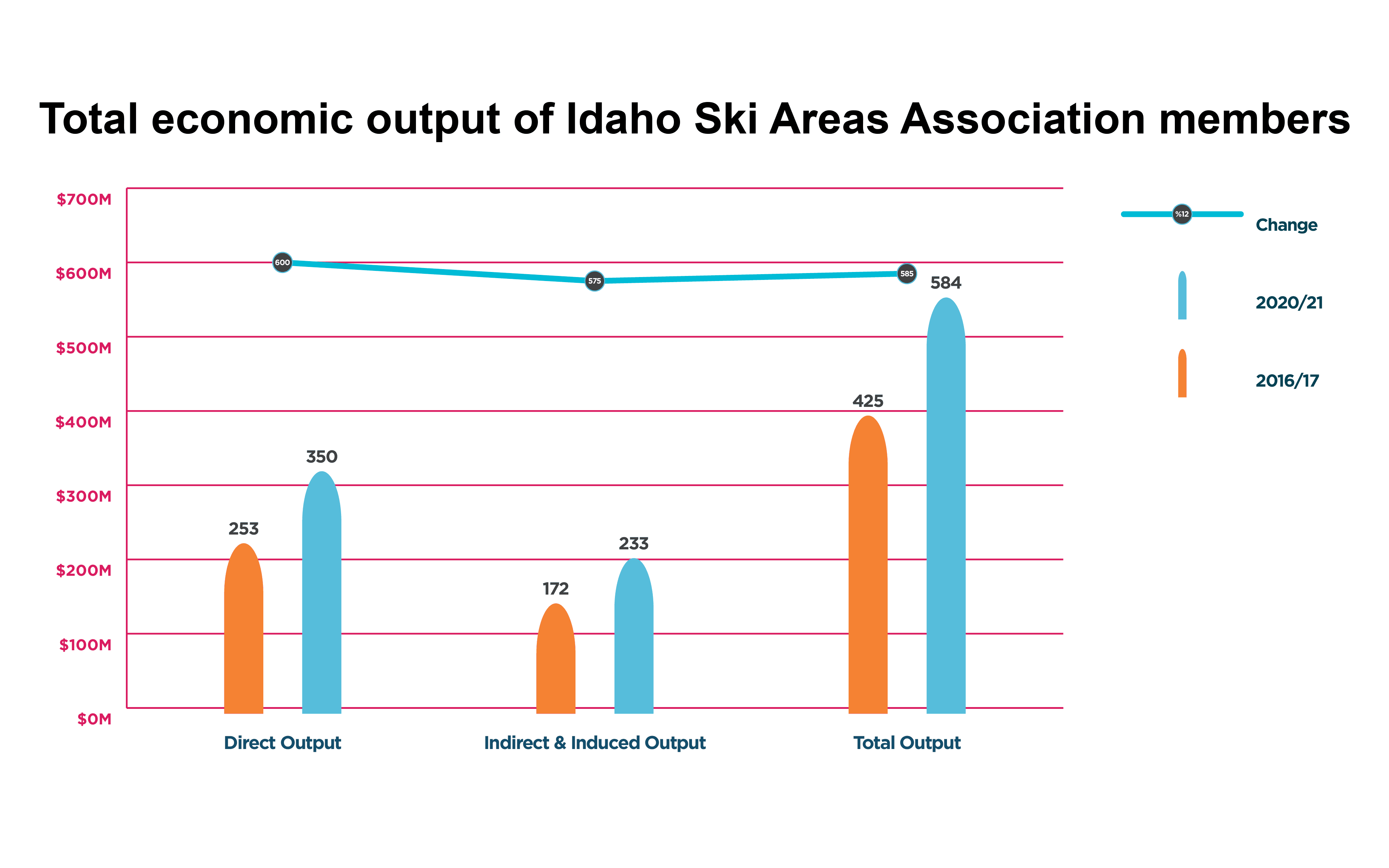
Economic Impact of Ski Industry Considerable
Skiers and snowboarders spent a total of $309 million in Idaho during the winter of 2020-21 — $151 million, (49 percent) at Idaho ski areas and $159 million (51 percent) at other businesses. The industry also directly or indirectly generated $309 million in gross domestic product in Idaho, equivalent to 0.33 percent of Idaho’s 2021 GDP.
Meanwhile, total economic output during fiscal year 2020-21 reached $584 million, increasing 37 percent from $425 million in FY 2016-17. This included $350 million in direct output (vs. $253 million in FY 2016-17) and $233 million in indirect and induced output (vs. $172 million in FY 2016-17).
Indirect effects are economic effects stemming from business-to-business purchases in the supply chain. Induced effects are economic effects stemming from household spending of labor income after removal of taxes, savings, and commuter income.
Between winter 2016-17 and winter 2020-21, Idaho ski area operators saw demand for lift tickets and season passes and rentals jump 41 percent and 29 percent, respectively. However, COVID-19 stalled the growth of lessons during that same period to 3 percent, while lodging and food-and-beverage operations each grew at a sluggish rate of 12 percent.
Meanwhile, summer operations in 2020 declined 4 percent compared to summer 2016, from $42.6 million to $41.0 million, respectively, due to the COVID-19 pandemic.
Capital expenditures for fiscal year 2020-21 were up 265 percent compared to FY 2016-17 at $67.9 million vs. $18.6 million, respectively. Investments in new and upgraded lifts climbed by 232 percent and expenditures on summer- and fall-specific facilities and support leapt 267 percent. Real estate was the clear leader, though, skyrocketing nearly 3,000 percent from the $1.6 million invested in FY 2016-17 to $48.9 million in FY 2020-21.
All this economic activity translated into 5,703 year-round equivalent jobs during FY 2020-21 — 4,266 direct jobs and 1,437 additional indirect and induced jobs. This represents 7 percent growth since FY 2016-17’s 5,345 total jobs.
Skiing and snowboarding generated $170 million in labor income — including $108 million directly and $61 million through multiplier effects. This represents growth of 26 percent compared to FY 2016-17’s $135 million in labor income. Labor income includes all forms of employment income, including wages, benefits, and proprietor income.
The report also noted the state’s thriving skiing and snowboarding industry helps provide seasonal balance to Idaho’s summer-dominated travel industry, contributes significantly to its quality of life, and likely improves employee recruitment and retention at Idaho businesses.
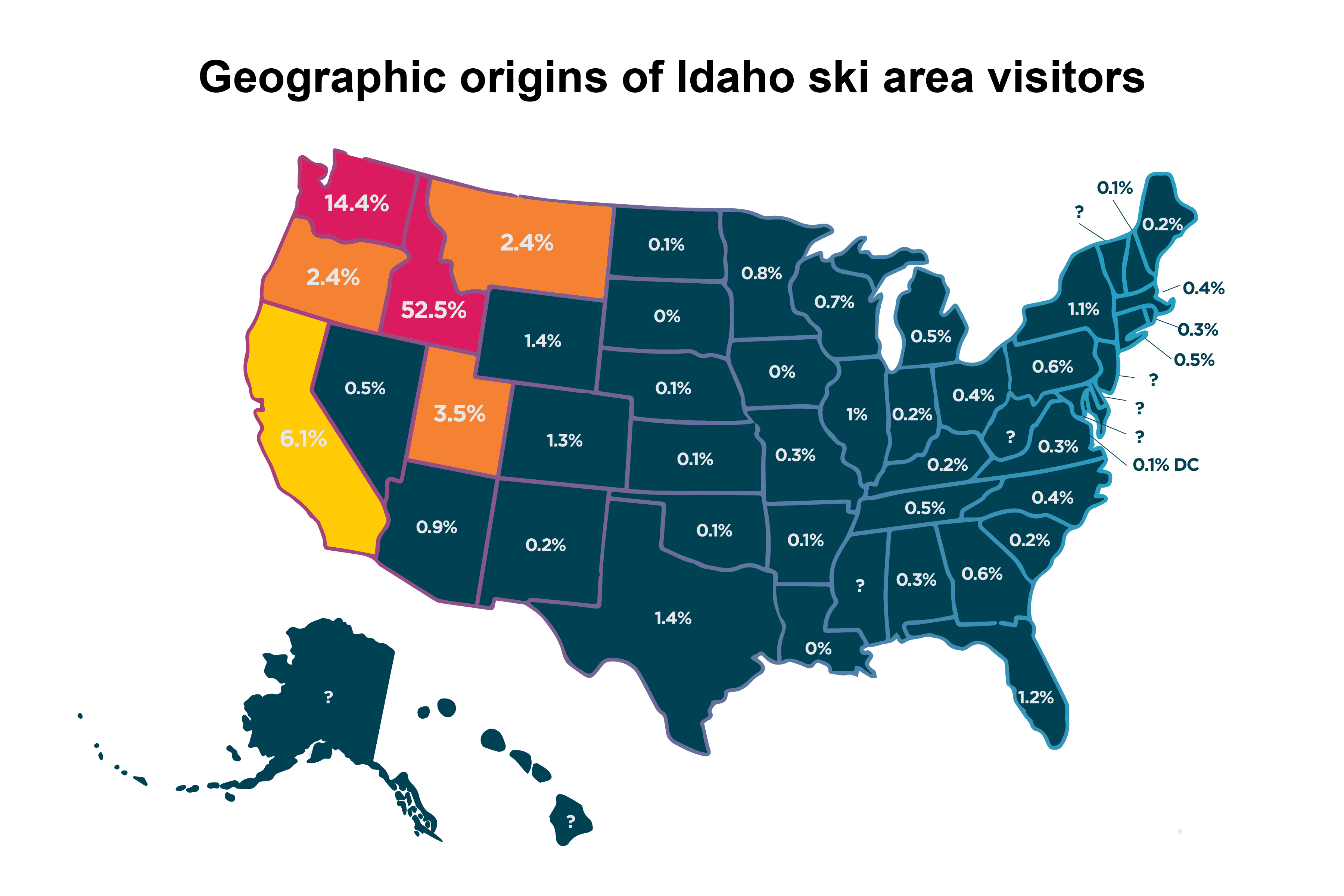
Nearly Half of Idaho Skiers From Out of State
Slightly more than half of Idaho ski area visitors in the winter of 2020-21—52.5 percent—resided in the Gem State and 47.5 percent were from out of state.
The greater Boise Designated Market Area accounted for nearly one-third of all skier visits that season—30.1 percent. The Spokane DMA, which includes a great deal of North Idaho, accounted for more than one-sixth of visits at 17.2 percent. The Idaho Falls/Pocatello, Seattle/Tacoma, and Twin Falls, Idaho, DMAs collectively represented another one-fifth of visits at 7.5 percent, 6.4 percent, and 5.8 percent, respectively.
Rounding out the top-10 hometowns of Idaho ski area visitors were Salt Lake City at 3.6 percent, Los Angeles at 2.3 percent, San Francisco/Oakland/San Jose at 2.0 percent, Portland at 1.7 percent, and New York City at 1.5 percent. Missoula, Mont., contributed 1.4 percent of visitors and Denver accounted for 1.1 percent, while Chicago and the Tri-Cities region of Washington State each proffered 0.9 percent. The area encompassing Sacramento, Stockton, and Modesto, Calif., represented 0.7 percent of Idaho’s 2020-21 skier visits, and all other U.S. and international markets comprised the remaining 16.1 percent.
Males, Households With Children, Slightly Affluent
Idaho skiers and snowboarders tended to be male, accounting for 58 percent of ski area visits vs. 42 percent for females. One-third were youths (18 percent are 12 or younger and 14 percent are ages 13-17), about one-fifth were between 18-34 (7 percent are 18-24 and 12 percent are 25-34), nearly one-third were between 35-54 (15 percent are 35-44 and 15 percent are 45-54), and another one-fifth were 55 or older (12 percent are 55-64, 6 percent are 65-74, and 1 percent are 75 or older).
Among survey respondents who were age 18 or older, households with children contributed the greatest number of skier and snowboarder visits at 39 percent, and households with children no longer at home ranked number two at 21 percent. Couples with no children accounted for 16 percent of visits and single individuals with no children comprised the remaining 20 percent.
Skiers visiting Idaho have a range of incomes but skew affluent. One-third, 34 percent, enjoyed annual pre-tax household income of $100,000-$199,999. One-fourth, 24 percent, earned $50,000-99,999. People reporting under $50,000 comprised 20 percent and those bringing in $200,000 or more annually accounted for the remaining 22 percent.
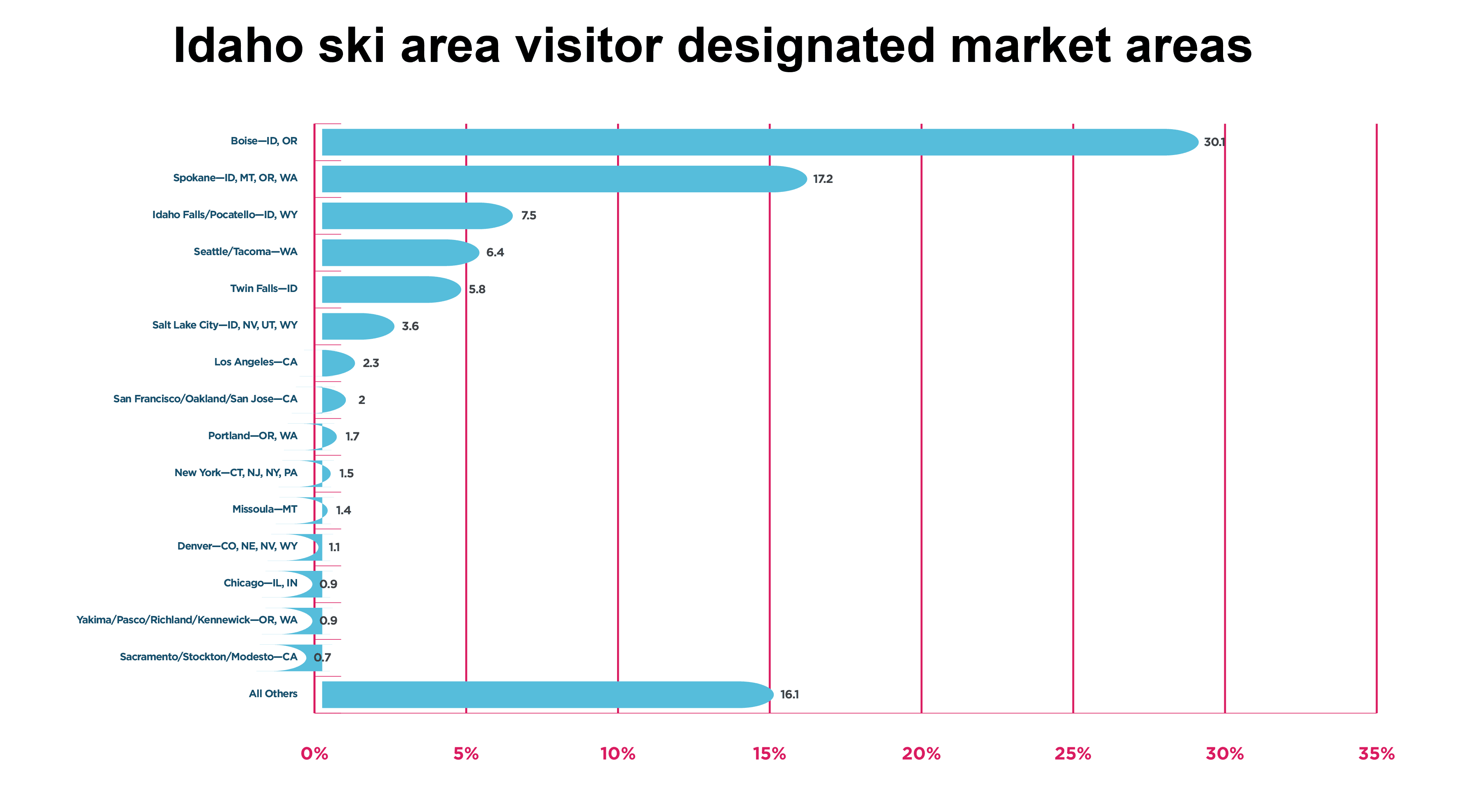
Mainly Season Passholders With Skills on Skis
The bulk of Idaho ski area visits—62 percent—were made by season passholders. Daily and multi-day passes comprised 33 percent of visits, with off-duty employee visits and comp tickets accounting for 3 percent and 2 percent, respectively.
Nearly three-quarters of visitors—72 percent—used alpine equipment and fully one-fourth—25 percent—rode snowboards. Other equipment like alpine touring and snowbikes accounted for 2 percent and 1 percent of visitors employed telemark gear.
About half—48 percent—considered themselves advanced or expert skiers or snowboarders and nearly as many—44 percent—ranked themselves as having intermediate abilities. Only 6 percent of visitors surveyed were beginners and only 2 percent were first-timers.
Two-thirds—66 percent—had visited their primary ski area within the prior five winters and one-third of winter visitors—33 percent—had visited the destination in the past five summers.
A little more than half of visits—56 percent—were day trips and 44 percent were overnighters. Most overnight visitors—61 percent—stayed in paid lodging and 11 percent stayed in an owned vacation home.
Ski Idaho’s Wilson was delighted to learn Gem State ski area visitors tend to express high satisfaction with their experience. On a scale of 1-10 (with 1 being extremely dissatisfied and 10 being extremely satisfied), Idaho ski areas earned ratings of 9.5 in overall employee service, 9.2 in overall lesson experience, 9.1 in quality of grooming, 9.0 in overall food and beverage, 8.7 in overall value for price paid, and 8.4 in overall rental experience.
“Whether it’s a world-class resort like Sun Valley or a mom-and-pop ski area, the quality of our on-mountain experience coupled with Idaho’s genuine friendliness is unparalleled. Combine that with our short lift lines and affordable lift tickets and you’d be hard pressed to find a better ski and snowboard destination than Idaho.”
– Brad Wilson
Visit https://skiidaho.us/blog/74-idaho-ski-areas-economic-impact-report to download a copy of the research report.